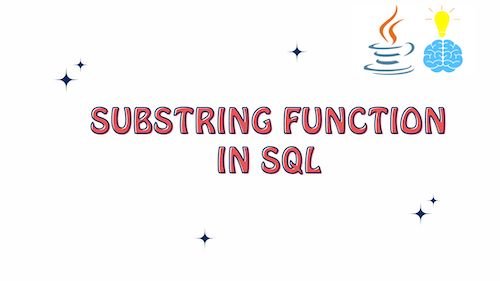In this article, we will explore “Substring Function in SQL” using relevant examples. Let’s get started.

What is Substring Function in SQL ?
The SQL SUBSTRING function, also known as SUBSTR in some database systems, is used to extract a portion of a string (text) from a larger string. It’s a commonly used string manipulation function in SQL and is available in most relational database management systems (RDBMS).
Here’s the basic syntax of the SQL SUBSTRING function:
SUBSTRING(string_expression, start_position, length)
string_expression: This is the source string from which you want to extract a substring.start_position: This is the starting position within the source string where you want to begin extracting the substring. It’s an integer value, and the counting starts from 1 for the first character.length: This is the length of the substring you want to extract. It’s an integer value specifying how many characters you want to include in the substring. If not specified, the function extracts characters from thestart_positionto the end of the source string.
Examples of SQL SUBSTRING Function
Here are some examples of using the SQL SUBSTRING function:
Extract a Substring from a String:
SELECT SUBSTRING('Hello, World!', 1, 5); -- Output: 'Hello'
In this example, we extract the first 5 characters from the string ‘Hello, World!’ starting from position 1.
Extract a Substring without Specifying Length:
SELECT SUBSTRING('Hello, World!', 7); -- Output: 'World!'
Here, we extract the substring starting from position 7 to the end of the string.
Extract a Substring Using a Column Value:
SELECT SUBSTRING(column_name, 3, 4) FROM table_name;
In this case, you can use the SUBSTRING function to extract a substring from a column value in a table.
Use SQL SUBSTRING with Other Functions:
SELECT CONCAT(SUBSTRING('Hello, World!', 1, 5), ' Universe'); -- Output: 'Hello Universe'
You can combine the SUBSTRING function with other string functions like CONCAT to manipulate and create new strings.
Best Practices: SQL Substring Function
Here are the best practices for using the SQL SUBSTRING function in a more concise format:
- Meaningful Aliases: Assign clear aliases to SUBSTRING results for better query readability.
- Avoid Hardcoding: Don’t hardcode start positions and lengths; use variables or parameters for flexibility.
- Validate Input: Ensure data meets expectations; add validation checks for varying data.
- Handle Nulls: Be cautious with NULL values; use IS NULL or IS NOT NULL checks.
- Optimize Performance: Index relevant columns for better SUBSTRING performance with large datasets.
- Avoid Deep Nesting: Steer clear of excessive nesting of string functions; use CTEs or break down logic for clarity.
Conclusion: Substring Function in SQL
The SQL SUBSTRING function is a valuable and versatile tool for efficiently extracting substrings from larger strings within a database. Its simplicity and ease of use make it an essential component of string manipulation in SQL. By adhering to best practices such as assigning meaningful aliases to SUBSTRING results, steering clear of hardcoded values, and optimizing for improved performance by indexing relevant columns, you can harness the full potential of the SUBSTRING function. This will not only enhance the readability and maintainability of your SQL queries but also empower you to execute data manipulation tasks with greater precision and efficiency, thereby elevating the overall quality of your database operations.
Related Articles :
- Views in SQL : Comprehensive Guide
- Constraints in SQL
- Aggregate Functions in SQL
- Triggers in SQL
- 7 Types of Join in SQL
- Create Table in SQL
- Different Types of SQL Statements: A Comprehensive Guide
- Using Limit in SQL Queries
- SQL Operators : Complete List
- Self Join in SQL with Examples
- Natural Join in SQL
- Cross Join in SQL: Comprehensive Guide
- Inner Join in SQL
- Left Join in SQL with Examples
- Right Join in SQL: Comprehensive Guide with Examples
- Full Join in SQL: Comprehensive Guide
- Outer Join in SQL: Comprehensive Guide
